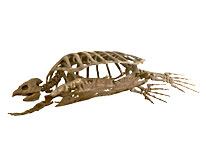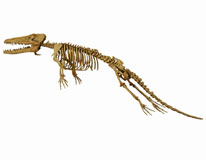- Home>
- Plan Your Visit>
- Our Exhibitions>
- Fossil Gallery>
- Cast of Characters
Cast of Characters
The fossil gallery has gathered a compelling cast of characters to lead visitors through a dramatic tale of extinction and survival. These are just some of the stars on exhibit at the Canadian Museum of Nature!
A Top Predator
Daspletosaurus torosus lived about 75 to 72 million years ago. The skeleton on exhibition was found in 1921 by Charles M. Sternberg, son of the renowned palaeontologist Charles H. Sternberg. It was originally identified as belonging to a species of Gorgosaurus, but further study in the 1960s at the Canadian Museum of Nature determined that it was a new genus and species. The specimen in the gallery is the holotype, which is the reference specimen for assigning others to that species.
First of Its Kind
Vagaceratops irvinensis was collected in 1958, but wasn’t removed from its plaster field jacket until 40 years later. Only then did palaeontologists at the Canadian Museum of Nature realize that it was a new species! The specimen in the gallery is the holotype of that species. The dinosaur lived about 72 million years ago.
Killer of the Seas
Platecarpus coryphaeus is a mosasaur that was collected in Kansas in the early 1900s by George F. Sternberg. In the gallery, the panel-mounted specimen is between 7 m and 8 m long. This marine reptile lived 88 to 85 million years ago.
The Largest Turtle Ever!
Archelon ischyros was the largest turtle that ever lived—about the size of a Volkswagen Beetle! The cast on display represents the largest-known, best-preserved specimen; it was discovered in South Dakota. The animal lived about 74 million years ago.
The Earliest-Known Whale
Pakicetus attocki lived about 50 million years ago. It probably spent more time on land than in the water, but it is an important link in the transition from land to sea. Its ears had some adaptations for hearing under water.
The Walking, Swimming Whale
Ambulocetus natans lived about 49 million years ago and shows the next stage in whale evolution.
The Largest Land Mammal of Its Time
A plant eater, Megacerops sp. (species unidentified) was a member of the brontothere family and lived 37 to 33 million years ago. Brontotheres were the largest land mammals of their time. They belonged to a group of odd-toed ungulates, which include today’s horses, tapirs and rhinos. The skeleton was originally on display from 1912 to 1969. It was remounted for display in the new gallery.








